An Exploratory Analysis of the Implementation and Use of an Intelligent Platform for Learning in Primary Education
Abstract
Featured Application
Abstract
1. Introduction and Background
Related Work
2. Description of Smile and Learn Platform
- Science: includes activities in the field of science, to work scientific methods and concepts.
- Spatial: includes activities working visual–spatial skills and cognitive–spatial skills.
- Logic: activities work logico-mathematical skills and others related with said field of knowledge.
- Literacy: contains activities as interactive tales, vocabulary, word games, etc., that work verbal-linguistic skills.
- Emotions: involves activities to develop emotional and intrapersonal skills.
- Arts: artistic activities such as painting, music, playing instruments.
- Multiplayer: includes games against the machine or classmates.
- An additional world named after the user, where the student can build two virtual villages and manage the resources earned by the activities done.
3. Materials and Methods
3.1. Participants and Cohorts
3.2. Pilots Training and in-Classroom Experience
3.3. Data Acquisition
3.4. Data Analysis
4. Results
4.1. Pilot Group 1
4.1.1. Pilot Group 1 Usage of the Different Worlds
4.1.2. Pilot Group 1 Games and Quizzes Scores
4.2. Pilot Group 2
4.2.1. Pilot Group 2 Usage of the Different Worlds
4.2.2. Pilot Group 2 Games and Quizzes Scores
4.3. Pilot Group 3
4.3.1. Pilot Group 3 Usage of the Different Worlds
4.3.2. Pilot Group 3 Games and Quizzes Scores
4.4. Analysis and Description of Usage among the Pilot Groups
5. Discussion
- A preferential use of applications within the STEM area was observed—the use of cross-curricular activities such as those found in the world of Spatial being notable. To maintain the use and interest in this area, it would be necessary to continue developing new content to be able to provide teachers with a variety of materials from which to choose, being able to adapt them to the classroom.
- In the case of the world of Emotions, materials shall continue with a deeper development in order to analyze whether there is an increase in their use by incorporating bigger diversity of contents, involving a motivating offer.
- The monitorization of pilot groups, as the incorporation of new pilot groups, raise the possibility of a longitudinal study in the use of technology and its implementation. To do this, it will be necessary to continue expanding the digital materials available through the platform. In that sense, a study of design changes and User Experience Research in conjunction with such implementation would be able to clarify how and where to improve the organization and management within the platform in order to increase its use.
- Emphasis is also to be placed on how to train teachers for an enhanced use of the activities within the Literacy world, such as debates and colloquies, which would serve to evaluate the reading comprehension of the present tales and narratives.
- In regard to the activities within the Multiplayer world, it would also be necessary to continue with the development of contents that can grow the time of dedication. Activities from this world can help to work interpersonal skills, cooperation and the underpinning social relations required in learning [28].
- As a new line of content development, the design of activities addressed to work in cooperation, and applied in different worlds, is suggested to analyze whether this type of material can help to improve performance by incorporating social variables, thus increasing students’ motivation, following many contemporary strategies in Collective User Experience Research and Social Gaming Interaction [21].
Study Limitations
6. Conclusions
Ethical Statements
Supplementary Materials
- Windows store—*If you are a teacher or a school ask for the link to download Windows version in this email: info@smileandlearn.com
- Linux—This version was made for several schools in 2018. You can get the link to download it with a request in this email: info@smileandlearn.com*Minimum system requirements to use Smile and Lear can be found in: https://smileandlearn.com/support/?lang=en
Author Contributions
Funding
Conflicts of Interest
Appendix A
| Artistic Use | Artistic Activities | |||||||||
| Groups | N | AVG | SD | Min. | Max. | N | AVG | SD | Min. | Max. |
| Pilot group | 170 | 9826.56 | 17,121.06 | 3.82 | 127,423.20 | 174 | 64.26 | 94.17 | 1 | 595 |
| 1st Cycle | 98 | 10,782.82 | 16,163.01 | 5.60 | 111,609.87 | 101 | 66.98 | 83.81 | 1 | 413 |
| 2nd Cycle | 61 | 9766.35 | 19,700.78 | 15.94 | 127,423.20 | 62 | 68.74 | 114.55 | 1 | 595 |
| Special Needs | 11 | 1640.96 | 2904.61 | 3.82 | 9992.91 | 11 | 14.09 | 13.07 | 1 | 40 |
| Emotion Use | Emotion Activities | |||||||||
| Groups | N | AVG | SD | Min. | Max. | N | AVG | SD | Min. | Max. |
| Pilot group | 119 | 1774.16 | 3060.49 | 25.64 | 24,036.19 | 124 | 10.58 | 14.19 | 1 | 108 |
| 1st Cycle | 72 | 2063.91 | 3624.60 | 41.90 | 24,036.19 | 75 | 11.39 | 15.81 | 1 | 108 |
| 2nd Cycle | 39 | 1421.99 | 2013.38 | 25.64 | 9874.73 | 41 | 9.85 | 12.22 | 1 | 59 |
| Special Needs | 8 | 883.18 | 415.44 | 234.95 | 1350.78 | 8 | 6.75 | 3.69 | 1 | 12 |
| Logic Use | Logic Activities | |||||||||
| Groups | N | AVG | SD | Min. | Max. | N | AVG | SD | Min. | Max. |
| Pilot group | 186 | 15,596.81 | 27,272.71 | 16.33 | 151,940.04 | 195 | 69.32 | 110.59 | 1 | 802 |
| 1st Cycle | 112 | 19,327.72 | 32,165.74 | 16.33 | 151,940.04 | 114 | 83.75 | 127.55 | 1 | 802 |
| 2nd Cycle | 60 | 11,419.98 | 17,442.54 | 26.63 | 88,205.33 | 66 | 55.21 | 83.48 | 1 | 350 |
| Special Needs | 14 | 3650.21 | 3966.94 | 575.47 | 13,970.74 | 15 | 21.73 | 27.43 | 1 | 105 |
| Science Use | Science Activities | |||||||||
| Groups | N | AVG | SD | Min. | Max. | N | AVG | SD | Min. | Max. |
| Pilot group | 183 | 19,869.85 | 27,187.81 | 10.69 | 172,020.99 | 187 | 77.51 | 104.766 | 1 | 539 |
| 1st Cycle | 108 | 23,814.70 | 30,216.55 | 16.16 | 172,020.99 | 109 | 87.52 | 104.24 | 1 | 532 |
| 2nd Cycle | 66 | 15,220.57 | 22,099.90 | 10.69 | 88,906.35 | 66 | 71.24 | 111.39 | 1 | 539 |
| Special Needs | 9 | 6626.48 | 7095.50 | 374.02 | 18,304.90 | 12 | 21.00 | 29.56 | 1 | 84 |
| Literacy Use | Literacy Activities | |||||||||
| Groups | N | AVG | SD | Min. | Max. | N | AVG | SD | Min. | Max. |
| Pilot group | 176 | 12,405.35 | 26,158.33 | 5.57 | 222,286.25 | 173 | 38.73 | 69.57 | 1 | 468 |
| 1st Cycle | 107 | 15,190.27 | 30,987.36 | 6.66 | 222,286.25 | 106 | 42.13 | 73.72 | 1 | 468 |
| 2nd Cycle | 54 | 9165.22 | 16,861.79 | 5.57 | 70,050.54 | 52 | 38.88 | 69.88 | 1 | 310 |
| Special Needs | 15 | 4204.15 | 590.31 | 60.86 | 24,115.12 | 15 | 14.13 | 13.611 | 1 | 40 |
| Spatial Use | Spatial Activities | |||||||||
| Groups | N | AVG | SD | Min. | Max. | N | AVG | SD | Min. | Max. |
| Pilot group | 170 | 8741.88 | 12,544.72 | 11.19 | 89,509.55 | 182 | 50.81 | 66.02 | 1 | 381 |
| 1st Cycle | 95 | 9641.73 | 11,621.43 | 22.62 | 51,541.68 | 104 | 56.19 | 66.29 | 1 | 381 |
| 2nd Cycle | 62 | 8220.88 | 14,736.52 | 11.19 | 89,509.55 | 65 | 47.38 | 70.29 | 1 | 326 |
| Special Needs | 13 | 4650.80 | 5336.12 | 490.91 | 19,238.01 | 13 | 24.92 | 25.79 | 2 | 80 |
| Multiplayer Use | Multiplayer Activities | |||||||||
| Groups | N | AVG | SD | Min. | Max. | N | AVG | SD | Min. | Max. |
| Pilot group | 142 | 7948.80 | 12,223.45 | 1.83 | 69,380.18 | 137 | 25.71 | 36.25 | 1 | 209 |
| 1st Cycle | 83 | 7381.98 | 11,149.32 | 7.02 | 69,380.18 | 81 | 22.26 | 25.49 | 1 | 112 |
| 2nd Cycle | 51 | 9826.25 | 14,349.57 | 1.83 | 64,100.06 | 48 | 34.96 | 50.14 | 1 | 209 |
| Special Needs | 8 | 1860.88 | 3285.24 | 13.56 | 9784.16 | 8 | 5.13 | 4.27 | 1 | 10 |
| Games | Quiz | |||||||||
|---|---|---|---|---|---|---|---|---|---|---|
| Groups | N | AVG Score (%) | SD | AVG N. Activities | SD | N | AVG Score (%) | SD | AVG N. Activities | SD |
| Pilot group | 152 | 79.86 | 17.04 | 257.83 | 1157.920 | 163 | 71.76 | 15.41 | 42.89 | 121.74 |
| 1st Cycle | 93 | 78.82 | 17.67 | 270.17 | 1192.90 | 98 | 70.82 | 15.94 | 54.13 | 153.74 |
| 2nd Cycle | 44 | 79.91 | 16.50 | 312.55 | 1280.83 | 53 | 72.14 | 13.71 | 28.55 | 37.02 |
| Special Needs | 15 | 86.21 | 13.89 | 20.80 | 26.75 | 12 | 77.61 | 17.89 | 14.42 | 19.06 |
| Artistic Use | Artistic Activities | |||||||||
| Groups | N | AVG | SD | Min. | Max. | N | AVG | SD | Min. | Max. |
| Pilot group | 193 | 27,719.85 | 68,252.91 | 9.86 | 531,629.10 | 199 | 164.26 | 359.32 | 1 | 2673 |
| 1st Cycle | 90 | 33,505.70 | 79,639.93 | 9.86 | 531,629.10 | 93 | 206.16 | 431.50 | 1 | 2673 |
| 2nd Cycle | 93 | 24,898.82 | 58,927.72 | 16.65 | 410,792.62 | 96 | 138.57 | 290.05 | 1 | 1910 |
| Special Needs | 10 | 1882.84 | 2204.86 | 158.60 | 7370.25 | 10 | 21.10 | 33.17 | 3 | 113 |
| Emotion Use | Emotion Activities | |||||||||
| Groups | N | AVG | SD | Min. | Max. | N | AVG | SD | Min. | Max. |
| Pilot group | 157 | 4446.52 | 8812.83 | 9.98 | 55,829.48 | 161 | 26.55 | 51.61 | 1 | 397 |
| 1st Cycle | 77 | 5332.82 | 9412.81 | 15.97 | 50,824.00 | 81 | 30.62 | 50.09 | 1 | 284 |
| 2nd Cycle | 69 | 3926.84 | 8723.41 | 9.98 | 55,829.48 | 69 | 24.90 | 56.79 | 1 | 397 |
| Special Needs | 11 | 1502.27 | 1819.15 | 34.63 | 5552.54 | 11 | 6.91 | 6.139 | 1 | 19 |
| Logic Use | Logic Activities | |||||||||
| Groups | N | AVG | SD | Min. | Max. | N | AVG | SD | Min. | Max. |
| Pilot group | 218 | 48,472.53 | 83,509.39 | 22.76 | 419,728.11 | 223 | 196.58 | 329.86 | 1 | 2289 |
| 1st Cycle | 101 | 64,579.17 | 93,543.72 | 24.69 | 419,728.11 | 104 | 249.01 | 352.87 | 1 | 1536 |
| 2nd Cycle | 104 | 36,945.43 | 74,620.57 | 22.76 | 395,131.96 | 106 | 162.01 | 318.12 | 1 | 2289 |
| Special Needs | 13 | 15,553.14 | 29,776.27 | 42.60 | 111,901.73 | 13 | 59.00 | 60.78 | 1 | 201 |
| Science Use | Science Activities | |||||||||
| Groups | N | AVG | SD | Min. | Max. | N | AVG | SD | Min. | Max. |
| Pilot group | 199 | 65,525.20 | 131,669.22 | 5.05 | 981,210.48 | 205 | 232.30 | 523.24 | 1 | 4649 |
| 1st Cycle | 101 | 75,372.20 | 128,321.35 | 5.05 | 919,615.53 | 102 | 280.31 | 587.11 | 1 | 4649 |
| 2nd Cycle | 89 | 60,165.53 | 140,741.02 | 56.15 | 981,210.48 | 94 | 199.13 | 467.54 | 1 | 3528 |
| Special Needs | 9 | 8021.09 | 10,176.30 | 1008.89 | 33,795.67 | 9 | 34.67 | 44.89 | 2 | 148 |
| Literacy Use | Literacy Activities | |||||||||
| Groups | N | AVG | SD | Min. | Max. | N | AVG | SD | Min. | Max. |
| Pilot group | 195 | 31,659.10 | 56,349.86 | 7.71 | 277,126.51 | 192 | 89.47 | 153.32 | 1 | 1083 |
| 1st Cycle | 96 | 39,578.60 | 64,180.87 | 7.71 | 277,126.51 | 92 | 110.88 | 170.92 | 1 | 1083 |
| 2nd Cycle | 86 | 24,798.65 | 47,093.59 | 33.67 | 210,477.69 | 87 | 75.10 | 140.88 | 1 | 793 |
| Special Needs | 13 | 18,561.21 | 44,604.50 | 29.67 | 165,803.56 | 13 | 34.08 | 45.30 | 1 | 165 |
| Spatial Use | Spatial Activities | |||||||||
| Groups | N | AVG | SD | Min. | Max. | N | AVG | SD | Min. | Max. |
| Pilot group | 194 | 25,151.84 | 48,206.98 | 5.11 | 312,566.48 | 203 | 151.51 | 288.29 | 1 | 2010 |
| 1st Cycle | 96 | 31,147.13 | 53,913.52 | 5.11 | 312,566.48 | 98 | 178.39 | 284.69 | 1 | 1680 |
| 2nd Cycle | 87 | 19,815.37 | 43,617.55 | 20.30 | 272,838.11 | 94 | 134.39 | 306.13 | 1 | 2010 |
| Special Needs | 11 | 15,036.10 | 13,091.39 | 218.67 | 39,115.06 | 11 | 58.36 | 41.75 | 4 | 111 |
| Multiplayer Use (seconds) | Multiplayer Activities | |||||||||
| Groups | N | AVG | SD | Min. | Max. | N | AVG | SD | Min. | Max. |
| Pilot group | 171 | 29,609.54 | 65,553.53 | 7.19 | 412,884.92 | 169 | 86.13 | 192.65 | 1 | 1449 |
| 1st Cycle | 82 | 26,188.26 | 45,509.16 | 12.10 | 263,742.04 | 82 | 75.01 | 131.38 | 1 | 822 |
| 2nd Cycle | 76 | 37,801.07 | 85,437.46 | 23.82 | 412,884.92 | 76 | 109.21 | 250.89 | 1 | 1449 |
| Special Needs | 13 | 3301.03 | 4592.43 | 7.19 | 14,096.72 | 11 | 9.55 | 10.65 | 2 | 31 |
| Games | Quiz | |||||||||
|---|---|---|---|---|---|---|---|---|---|---|
| Groups | N | AVG Score (%) | SD | AVG N. Activities | SD | N | AVG Score (%) | SD | AVG N. Activities | SD |
| Pilot group | 188 | 81.37 | 15.52 | 30.,66 | 563.85 | 172 | 71.11 | 14.67 | 83.36 | 152.42 |
| 1st Cycle | 94 | 79.67 | 14.26 | 35.,50 | 509.81 | 83 | 71.63 | 13.51 | 95.80 | 156.79 |
| 2nd Cycle | 82 | 83.33 | 16.763 | 26.,82 | 647.25 | 78 | 70.80 | 15.60 | 80.31 | 156.48 |
| Special Needs | 12 | 81.34 | 15.86 | 127.92 | 243.97 | 11 | 69.40 | 17.45 | 11.18 | 8.38 |
| Artistic Use | Artistic Activities | |||||||||
| Groups | N | AVG | SD | Min. | Max. | N | AVG | SD | Min. | Max. |
| Pilot group | 84 | 31,250.71 | 163,063.60 | 12.73 | 1,491,804.00 | 91 | 71.07 | 112.75 | 1 | 497 |
| 1st Cycle | 47 | 51,860.93 | 216,275.02 | 12.73 | 1,491,804.00 | 49 | 107.57 | 125.03 | 1 | 477 |
| 2nd Cycle | 31 | 5293.09 | 18,044.86 | 35.04 | 101,180.99 | 35 | 28.40 | 83.46 | 1 | 497 |
| Special Needs | 6 | 3918.33 | 6329.017 | 87.99 | 16,733.36 | 7 | 28.86 | 50.94 | 1 | 143 |
| Emotion Use | Emotion Activities | |||||||||
| Groups | N | AVG | SD | Min. | Max. | N | AVG | SD | Min. | Max. |
| Pilot group | 60 | 29,524.73 | 178,283.01 | 7.21 | 1,369,570.00 | 64 | 16.69 | 26.77 | 1 | 176 |
| 1st Cycle | 33 | 10,108.32 | 38,330.58 | 7.21 | 222,313.00 | 35 | 18.69 | 19.66 | 1 | 85 |
| 2nd Cycle | 20 | 71,348.58 | 305,680.25 | 28.38 | 1,369,570.00 | 22 | 15.73 | 38.35 | 1 | 176 |
| Special Needs | 7 | 1562.57 | 1959.80 | 63.33 | 5234.92 | 7 | 9.71 | 10.31 | 1 | 27 |
| Logic Use | Logic Activities | |||||||||
| Groups | N | AVG | SD | Min. | Max. | N | AVG | SD | Min. | Max. |
| Pilot group | 99 | 94,201.08 | 345,837.19 | 50.83 | 2,584,213.00 | 101 | 117.42 | 183.32 | 1 | 1000 |
| 1st Cycle | 52 | 57,222.47 | 79,994.35 | 50.83 | 427,713.25 | 53 | 169.47 | 216.90 | 1 | 1000 |
| 2nd Cycle | 38 | 115,441.40 | 465,793.07 | 196.25 | 2584,213.00 | 39 | 60.72 | 123.61 | 2 | 583 |
| Special Needs | 9 | 218,173.95 | 626,554.53 | 518.53 | 1888,822.00 | 9 | 56.56 | 62.42 | 10 | 199 |
| Science Use | Science Activities | |||||||||
| Groups | N | AVG | SD | Min. | Max. | N | AVG | SD | Min. | Max. |
| Pilot group | 106 | 36,608.86 | 130,440.98 | 12.76 | 1,315,118.00 | 107 | 85.77 | 130.70 | 1 | 564 |
| 1st Cycle | 54 | 36,704.26 | 39,020.71 | 19.95 | 144,816.80 | 54 | 130.43 | 146.98 | 1 | 564 |
| 2nd Cycle | 44 | 42,023.57 | 198,589.15 | 12.76 | 1,315,118.00 | 45 | 43.51 | 99.31 | 1 | 562 |
| Special Needs | 8 | 6184.08 | 13,864.81 | 261.42 | 40,421.66 | 8 | 22.00 | 39.76 | 2 | 120 |
| Literacy Use | Literacy Activities | |||||||||
| Groups | N | AVG | SD | Min. | Max. | N | AVG | SD | Min. | Max. |
| Pilot group | 95 | 53,621.70 | 200,797.90 | 31.29 | 1,640,275.00 | 173 | 67.44 | 107.48 | 1 | 545 |
| 1st Cycle | 51 | 56,068.24 | 153,437.73 | 54.05 | 1,082,520.00 | 51 | 91.63 | 124.51 | 1 | 545 |
| 2nd Cycle | 36 | 13,724.16 | 27,516.70 | 31.29 | 151,525.55 | 36 | 39.06 | 82.60 | 1 | 483 |
| Special Needs | 8 | 217,563.95 | 574,925.59 | 2037.86 | 1,640,275.00 | 8 | 41.00 | 32.82 | 6 | 95 |
| Spatial Use | Spatial Activities | |||||||||
| Groups | N | AVG | SD | Min. | Max. | N | AVG | SD | Min. | Max. |
| Pilot group | 92 | 56,694.08 | 250,706.69 | 5.79 | 2,004,300.00 | 101 | 88.15 | 138.04 | 1 | 724 |
| 1st Cycle | 49 | 93,531.61 | 337,794.80 | 5.79 | 2,004,300.00 | 52 | 133.92 | 167.15 | 1 | 724 |
| 2nd Cycle | 34 | 14,313.01 | 54,684.76 | 57.53 | 320,106.00 | 40 | 31.12 | 70.82 | 1 | 420 |
| Special Needs | 9 | 16,240.44 | 14,445.52 | 269.56 | 43,843.75 | 9 | 77.11 | 74.99 | 2 | 231 |
| Multiplayer Use | Multiplayer Activities | |||||||||
| Groups | N | AVG | SD | Min. | Max. | N | AVG | SD | Min. | Max. |
| Pilot group | 77 | 80,237.00 | 370,084.40 | 5.25 | 2,865,876.00 | 76 | 23.55 | 37.78 | 1 | 187 |
| 1st Cycle | 41 | 116,061.52 | 472,703.70 | 68.72 | 2,865,876.00 | 41 | 30.10 | 39.69 | 1 | 168 |
| 2nd Cycle | 29 | 47,629.73 | 219,409.06 | 5.25 | 1,185,030.00 | 28 | 15.71 | 35.48 | 1 | 187 |
| Special Needs | 7 | 5494.89 | 10,867.64 | 296.96 | 29,861.98 | 7 | 16.57 | 32.25 | 1 | 89 |
| Games | Quiz | |||||||||
|---|---|---|---|---|---|---|---|---|---|---|
| Groups | N | AVG Score (%) | SD | AVG N. Activities | SD | N | AVG Score (%) | SD | AVG N. Activities | SD |
| Pilot group | 86 | 82.15 | 14.89 | 167.58 | 345.47 | 82 | 74.33 | 13.12 | 55.17 | 73.52 |
| 1st Cycle | 47 | 84.25 | 10.33 | 249.57 | 434.95 | 45 | 73.08 | 13.59 | 81.22 | 81.45 |
| 2nd Cycle | 30 | 78.24 | 19.78 | 67.57 | 155.53 | 29 | 75.59 | 11.77 | 23.62 | 49.99 |
| Special Needs | 9 | 84.26 | 15.36 | 72.78 | 73.95 | 8 | 76.86 | 15.94 | 23.00 | 34.28 |
References
- Chaw, L.Y.; Tang, C.M. What makes learning management systems effective for learning? J. Educ. Technol. Syst. 2018, 47, 152–169. [Google Scholar] [CrossRef]
- Luo, Y.F.; Yang, S.C. The effect of the interactive functions of whiteboards on elementary students’ learning. J. Educ. Technol. Syst. 2016, 54, 680–700. [Google Scholar] [CrossRef]
- Liu, M.; Scordino, R.; Geurtz, R.; Navarrete, C.; Ko, Y.; Lim, M. A Look at Research on Mobile Learning in K–12 Education from 2007 to the Present. J. Res. Technol. Educ. 2014, 46, 325–372. [Google Scholar] [CrossRef]
- McKnight, K.; O’Malley, K.; Ruzic, R.; Horsley, M.K.; Franey, J.J.; Bassett, K. Teaching in a digital age: How educators use technology to improve student learning. J. Res. Technol. Educ. 2016, 48, 194–211. [Google Scholar] [CrossRef]
- Imbriale, R.; Schiner, N.; Elmendorf, D. Students and Teachers Accessing Tomorrow (STAT): Baltimore County Public School’s One-to-One Digital Conversion Case in Practice. Comput. Sch. 2017, 34, 3–8. [Google Scholar] [CrossRef]
- Chou, C.C.; Block, L.; Jesness, R. A case study of mobile learning pilot project in K-12 schools. J. Educ. Technol. Dev. Exch. 2012, 5, 3. [Google Scholar] [CrossRef]
- McLean, K.J. The implementation of bring your own device (BYOD) in primary [elementary] schools. Front. Psychol. 2016, 7. [Google Scholar] [CrossRef]
- Hopkins, N.; Tate, M.; Sylvester, A.; Johnstone, D. Motivations for 21st century school children to bring their own device to school. Inf. Syst. Front. 2017, 19, 1191–1203. [Google Scholar] [CrossRef]
- Baek, Y.K. What hinders teachers in using computer and video games in the classroom? Exploring factors inhibiting the uptake of computer and video games. CyberPsychol. Behav. 2008, 11, 665–671. [Google Scholar] [CrossRef]
- Choppin, J.; Borys, Z. Trends in the design, development, and use of digital curriculum materials. ZDM Math. Educ. 2017, 49, 663–674. [Google Scholar] [CrossRef]
- Zhang, D.; Zhou, L.; Briggs, R.O.; Nunamaker, J.F., Jr. Instructional video in e-learning: Assessing the impact of interactive video on learning effectiveness. Inf. Manag. 2006, 43, 15–27. [Google Scholar] [CrossRef]
- Goldin, A.P.; Hermida, M.J.; Shalom, D.E.; Costa, M.E.; Lopez-Rosenfeld, M.; Segretin, M.S.; Fernández-Slezak, D.; Lipina, S.J.; Sigman, M. Far transfer to language and math of a short software-based gaming intervention. Proc. Natl. Acad. Sci. USA 2014, 111, 6443–6448. [Google Scholar] [CrossRef] [PubMed]
- Lin, M.H.; Chen, H.C.; Liu, K.S. A study of the effects of digital learning on learning motivation and learning outcome. Eurasia J. Math. Sci. Technol. Educ. 2017, 13, 3553–3564. [Google Scholar] [CrossRef]
- Chauhan, S. A meta-analysis of the impact of technology on learning effectiveness of elementary students. Comput. Educ. 2017, 105, 14–30. [Google Scholar] [CrossRef]
- Zhao, D.; Bogusevschi, D.; Muntean, G.M. Improving Future STEM Education with Innovative Learning Management System and Technology-Enhanced Learning Materials. In Proceedings of the International Conference on Engaging Pedology (ICEP), Dublin City University, Dublin, Ireland, 14–15 December 2018; Available online: http://www.newtonproject.eu/wp-content/uploads/2019/08/Dan_Diana_Gabriel_ICEP-paper.pdf (accessed on 10 December 2019).
- Martin, J.M. Digital Internships: Enriching Teaching and Learning with Primary Resources. In Best Practices in Teaching Digital Literacies; Literacy Research; Ortlieb, E., Cheek, E., Semingson, P., Eds.; Emerald Publishing Limited: Bingley, UK, 2018; pp. 109–121. [Google Scholar] [CrossRef]
- Erhel, S.; Jamet, E. Digital game-based learning: Impact of instructions and feedback on motivation and learning effectiveness. Comput. Educ. 2013, 67, 156–167. [Google Scholar] [CrossRef]
- Bogusevschi, D.; Maddi, M.; Muntean, G.M. Teachers’ Impact and Feedback Related to Technology Enhanced Learning in STEM Education in Primary and Secondary Schools. In Proceedings of the Ireland International Conference on Education (IICE), Dublin, Ireland, April 2019; Available online: http://www.newtonproject.eu/wp-content/uploads/2019/08/DBogusevschiEtAll-IICE2019-Final.pdf (accessed on 10 December 2019).
- Pepin, B.; Choppin, J.; Ruthven, K.; Sinclair, N. Digital curriculum resources in mathematics education: Foundations for change. ZDM Math. Educ. 2017, 49, 645–661. [Google Scholar] [CrossRef]
- Bellotti, F.; Ott, M.; Arnab, S.; Berta, R.; de Freitas, S.; Kiili, K.; De Gloria, A. Designing Serious Games for Education: from Pedagogical Principles to Game Mechanisms. In Proceedings of the 5th European Conference on Games Based Learning, Athens, Greece, 20 October 2011; pp. 26–34. Available online: https://hal.archives-ouvertes.fr/docs/00/98/58/00/PDF/BELLOTTI_ET_AL.pdf (accessed on 18 November 2019).
- Ke, F. Computer games application within alternative classroom goal structures: Cognitive, metacognitive, and affective evaluation. Educ. Technol. Res. Dev. 2008, 56, 539–556. [Google Scholar] [CrossRef]
- Blumberg, F.C.; Fisch, S.M. Introduction: Digital games as a context for cognitive development, learning, and developmental research. New Dir. Child Adolesc. Dev. 2013, 139, 1–9. [Google Scholar] [CrossRef]
- Diamond, A. Activities and programs that improve children’s executive functions. Curr. Dir. Psychol. Sci. 2012, 21, 335–341. [Google Scholar] [CrossRef]
- González-Pienda, J.A. El rendimiento escolar. Un análisis de las variables que lo condicionan. Revista Galego-Portuguesa de psicoloxía e Educación 2003, 7, 247–258. [Google Scholar]
- Bahri, A.; Corebima, A.D. The contribution of learning motivation and metacognitive skill on cognitive learning outcome of students within different learning strategies. J. Balt. Sci. Educ. 2015, 14, 487–500. [Google Scholar]
- Hirsh-Pasek, K.; Zosh, J.M.; Golinkoff, R.M.; Gray, J.H.; Robb, M.B.; Kaufman, J. Putting education in “educational” apps: Lessons from the science of learning. Psychol. Sci. Public Interest 2015, 16, 3–34. [Google Scholar] [CrossRef] [PubMed]
- Mateos, M.J.; Muñoz-Merino, P.J.; Kloos, C.D.; Hernández-Leo, D.; Redondo-Martínez, D. Design and evaluation of a computer-based game for education. IEEE Front. Educ. Conf. 2016, 1–8. [Google Scholar] [CrossRef]
- Huffaker, D.A.; Calvert, S.L. The new science of learning: Active learning, metacognition, and transfer of knowledge in e-learning applications. J. Educ. Comput. Res. 2003, 29, 325–334. [Google Scholar] [CrossRef]
- Uluyol, Ç.; Şahin, S. Elementary school teachers’ ICT use in the classroom and their motivators for using ICT. Br. J. Educ. Technol. 2016, 47, 65–75. [Google Scholar] [CrossRef]
- Bikowski, D.; Casal, J.E. Interactive Digital Textbooks and Engagement: A Learning Strategies Framework. Lang. Learn. Technol. 2018, 22, 119–136. Available online: https://scholarspace.manoa.hawaii.edu/bitstream/10125/44584/2/22_01_bikowskicasal.pdf (accessed on 18 November 2019).
- Baptista, R.; Coelho, A.; de Carvalho, C.V. Relationship between game categories and skills development: Contributions for serious game design. 9th Proc. Eur. Conf. Game Based Learn. 2015, 1, 34–42. [Google Scholar]
- Sligte, H. Best of The Netherlands: International Computer Supported Collaborative Learning-Projects in Education. Old Dreams and Current Realities. EdMedia Innov. Learn 2019, 1015–1022, Association for the Advancement of Computing in Education (AACE). Available online: https://www.learntechlib.org/primary/p/210107/ (accessed on 10 December 2019).
- Sohrabi, B.; Iraj, H. Implementing flipped classroom using digital media: A comparison of two demographically different groups perceptions. Comput. Hum. Behav. 2016, 60, 514–524. [Google Scholar] [CrossRef]
- Szabó, I.; Lipóczi, S. Teaching and Learning Foreign Languages with Interactive Methods. Gradus 2015, 2, 80–90. Available online: http://gradus.kefo.hu/archive/2015-1/2015_1_ART_008_Szabo.pdf (accessed on 18 November 2019).
- Kreijns, K.; Van Acker, F.; Vermeulen, M.; Van Buuren, H. What stimulates teachers to integrate ICT in their pedagogical practices? The use of digital learning materials in education. Comput. Hum. Behav. 2013, 29, 217–225. [Google Scholar] [CrossRef]
- Arnab, S.; Clarke, S. Towards a trans-disciplinary methodology for a game-based intervention development process. Br. J. Educ. Technol. 2017, 48, 279–312. [Google Scholar] [CrossRef]
- Comi, S.L.; Argentin, G.; Gui, M.; Origo, F.; Pagani, L. Is it the way they use it? Teachers, ICT and student achievement. Econ. Educ. Rev. 2017, 56, 24–39. [Google Scholar] [CrossRef]
- Bekker, T.; Bakker, S.; Douma, I.; Van Der Poel, J.; Scheltenaar, K. Teaching children digital literacy through design-based learning with digital toolkits in schools. Int. J. Child Comput. Interact. 2015, 5, 29–38. [Google Scholar] [CrossRef]
- Lim, T.; Carvalho, M.B.; Bellotti, F.; Arnab, S.; De Freitas, S.; Louchart, S.; Suttie, N.; Berta, R.; De Gloria, A. The Lm-Gm Framework for Serious Games Analysis. Retrieved Oct. 2015, 3. Available online: Chrome-extension://oemmndcbldboiebfnladdacbdfmadadm/http://citeseerx.ist.psu.edu/viewdoc/download?doi=10.1.1.678.6172&rep=rep1&type=pdf (accessed on 18 November 2019).
- Mayer, R.E. Cognitive Theory of Multimedia Learning. Camb. Handb. Multimed. Learn. 2005, 41, 31–48. Available online: https://s3.amazonaws.com/academia.edu.documents/40593413/mayer2005ch3.pdf?response-content-disposition=inline%3B%20filename%3DMayer2005ch3.pdf&X-Amz-Algorithm=AWS4-HMAC-SHA256&X-Amz-Credential=AKIAIWOWYYGZ2Y53UL3A%2F20200202%2Fus-east-1%2Fs3%2Faws4_request&X-Amz-Date=20200202T184037Z&X-Amz-Expires=3600&X-Amz-SignedHeaders=host&X-Amz-Signature=d35c6aa65981b6cafaec97f977b840ee218ef5eff4dd6a56b792a87823f856c2 (accessed on 10 December 2019).
- Pérez, M.D.M.; Duque, A.G.; Garca, L.F. Game-based learning: Increasing the logical-mathematical, naturalistic, and linguistic learning levels of primary school students. J. New Approaches Educ. Res. 2018, 7, 31–39. [Google Scholar] [CrossRef]
- Sajjadi, P.; Vlieghe, J.; De Troyer, O. Evidence-based mapping between the theory of multiple intelligences and game mechanics for the purpose of player-centered serious game design. In Proceedings of the 8th International Conference on Games and Virtual Worlds for Serious Applications, Barcelona, Spain, 7–9 September 2016; pp. 1–8. [Google Scholar] [CrossRef]
- Chen, M.H.M.; Tsai, S.T.; Chang, C.C. Effects of Game-Based Instruction on the Results of Primary School Children Taking a Natural Science Course. Educ. Sci. 2019, 9, 79. [Google Scholar] [CrossRef]
- Selwyn, N.; Cooper, R. The potential of digital technology for science learning and teaching—The learners’ perspective. In The Future in Learning Science: What’s in it for the Learner? Corrigan, D., Buntting, C., Dillon, J., Jones, A., Gunstone, R., Eds.; Springer: Cham, Switzerland, 2015; pp. 263–277. [Google Scholar] [CrossRef]
- Fokides, E. Digital educational games and mathematics. Results of a case study in primary school settings. Educ. Inf. Technol. 2018, 23, 851–867. [Google Scholar] [CrossRef]
- Dooly, M.; Masats, D. A critical appraisal of foreign language research in content and language integrated learning, young language learners, and technology-enhanced language learning published in Spain (2003–2012). Lang. Teach. 2015, 48, 343–372. [Google Scholar] [CrossRef]
- Šimandl, V.; Novotný, J. Using Local ICT Services to Support Lower Secondary and Primary School Teaching. Int. J. Inf. Commun. Technol. Educ. 2017, 6, 19–29. [Google Scholar] [CrossRef]
- Santiago, K.; Lukas, J.F.; Etxeberria, J.; Gobantes, A. Evaluation of the IKASYS Programme. Res. Reflect. Innov. Integr. ICT Educ. 2009, 51–54. Available online: https://pdfs.semanticscholar.org/1035/483ae0a70c9c4db6947faf1f7e9e1e45778d.pdf (accessed on 20 October 2019).
- Herder, T.; Swiecki, Z.; Fougt, S.S.; Tamborg, A.L.; Allsopp, B.B.; Shaffer, D.W.; Misfeldt, M. Supporting teachers’ intervention in students’ virtual collaboration using a network based model. In Proceedings of the 8th International Conference on Learning Analytics and Knowledge, Sydney, NSW, Australia, 5–9 March 2018; pp. 21–25. [Google Scholar] [CrossRef]
- Wang, B.; Liu, H.; An, P.; Li, Q.; Li, K.; Chen, L.; Zhang, Q.; Zhang, X.; Gu, S. Artificial Intelligence and Education. In Reconstructing Our Orders; Jin, D., Ed.; Springer: Singapore, 2018; pp. 129–161. [Google Scholar] [CrossRef]
- Chassignol, M.; Khoroshavin, A.; Klimova, A.; Bilyatdinova, A. Artificial Intelligence trends in education: A narrative overview. Procedia Comput. Sci. 2018, 136, 16–24. [Google Scholar] [CrossRef]
- Martin, F.; Ndoye, A.; Wilkins, P. Using learning analytics to enhance student learning in online courses based on quality Matters standards. J. Educ. Technol. Syst. 2016, 45, 165–187. [Google Scholar] [CrossRef]
- Wilson, A.; Watson, C.; Thompson, T.L.; Drew, V.; Doyle, S. Learning analytics: Challenges and limitations. Teach. High. Educ. 2017, 22, 991–1007. [Google Scholar] [CrossRef]
- Gardner, H. Multiple Intelligences; Basic Books: New York, NY, USA, 1983. [Google Scholar]
- Baldominos, A.; Quintana, D. Data-Driven Interaction Review of an Ed-Tech Application. Sensors 2019, 19, 1910. [Google Scholar] [CrossRef]
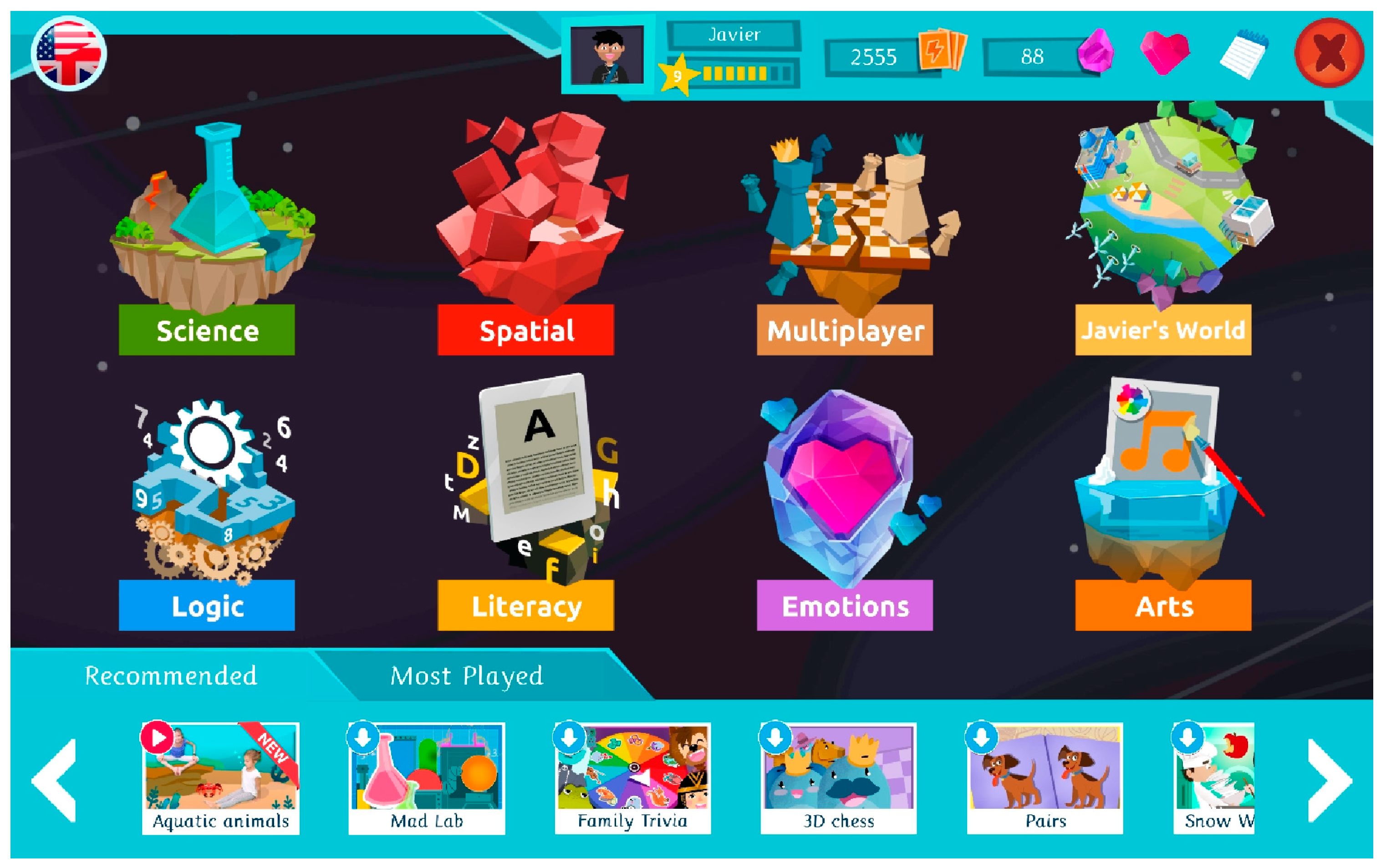
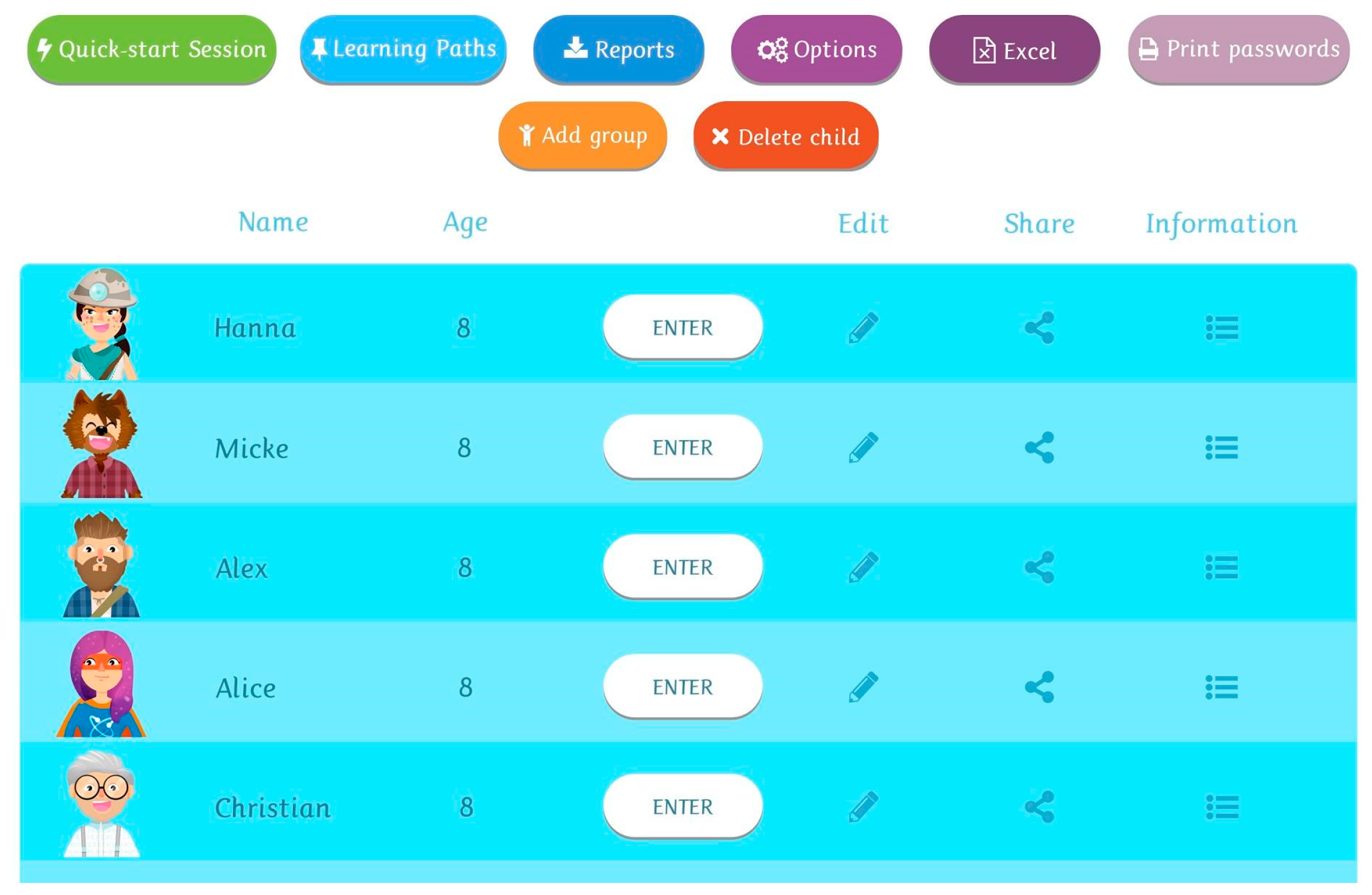
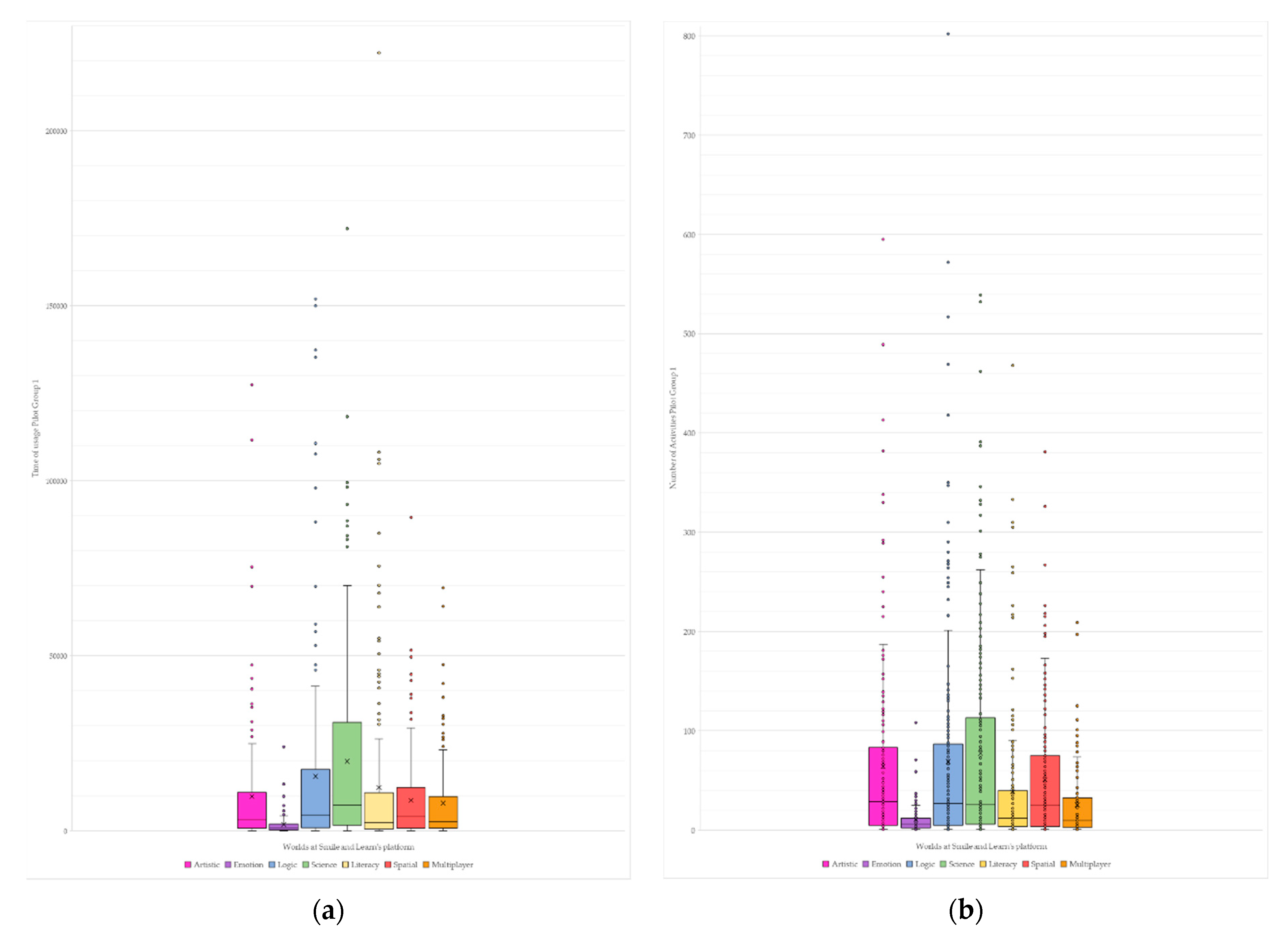
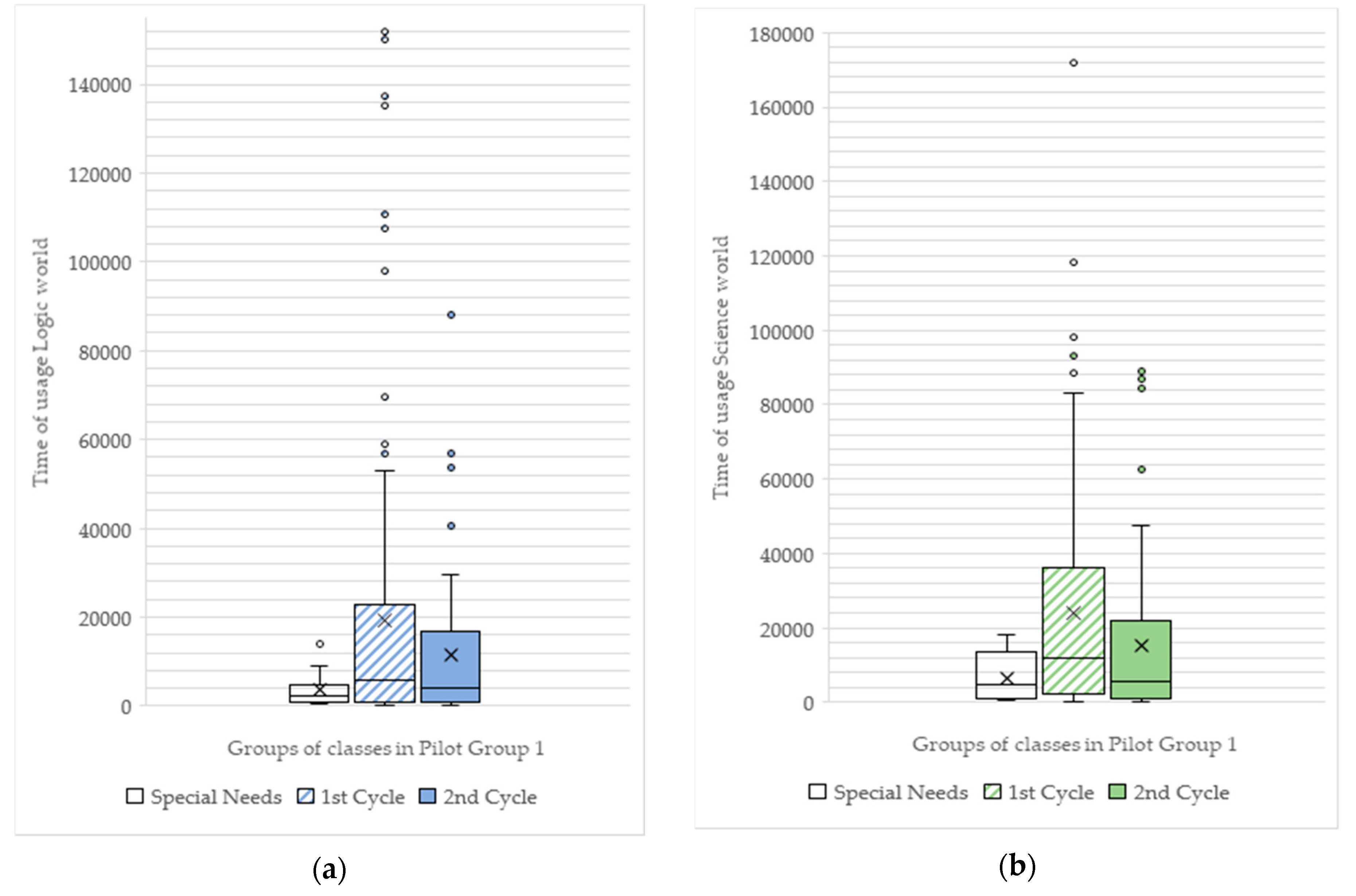
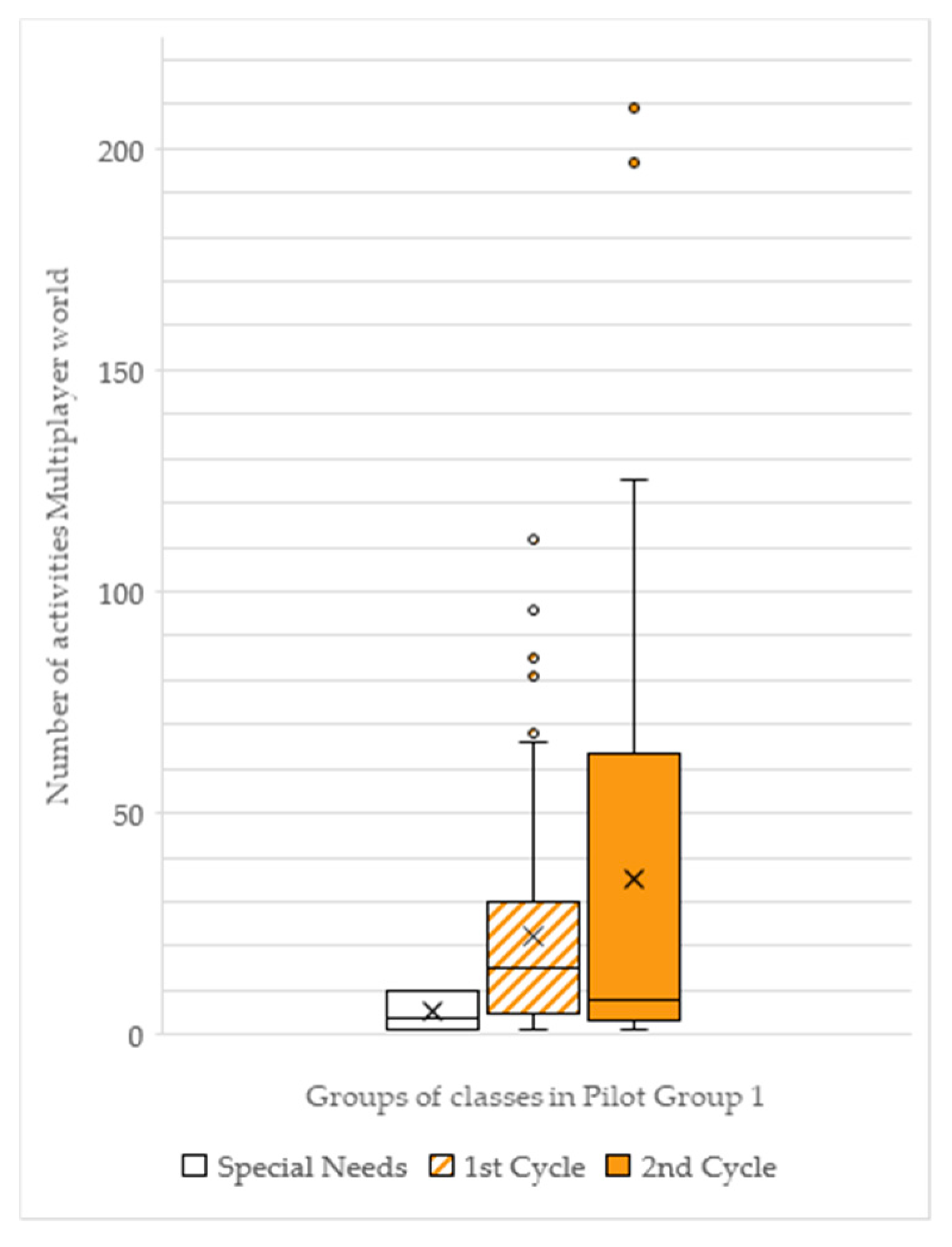
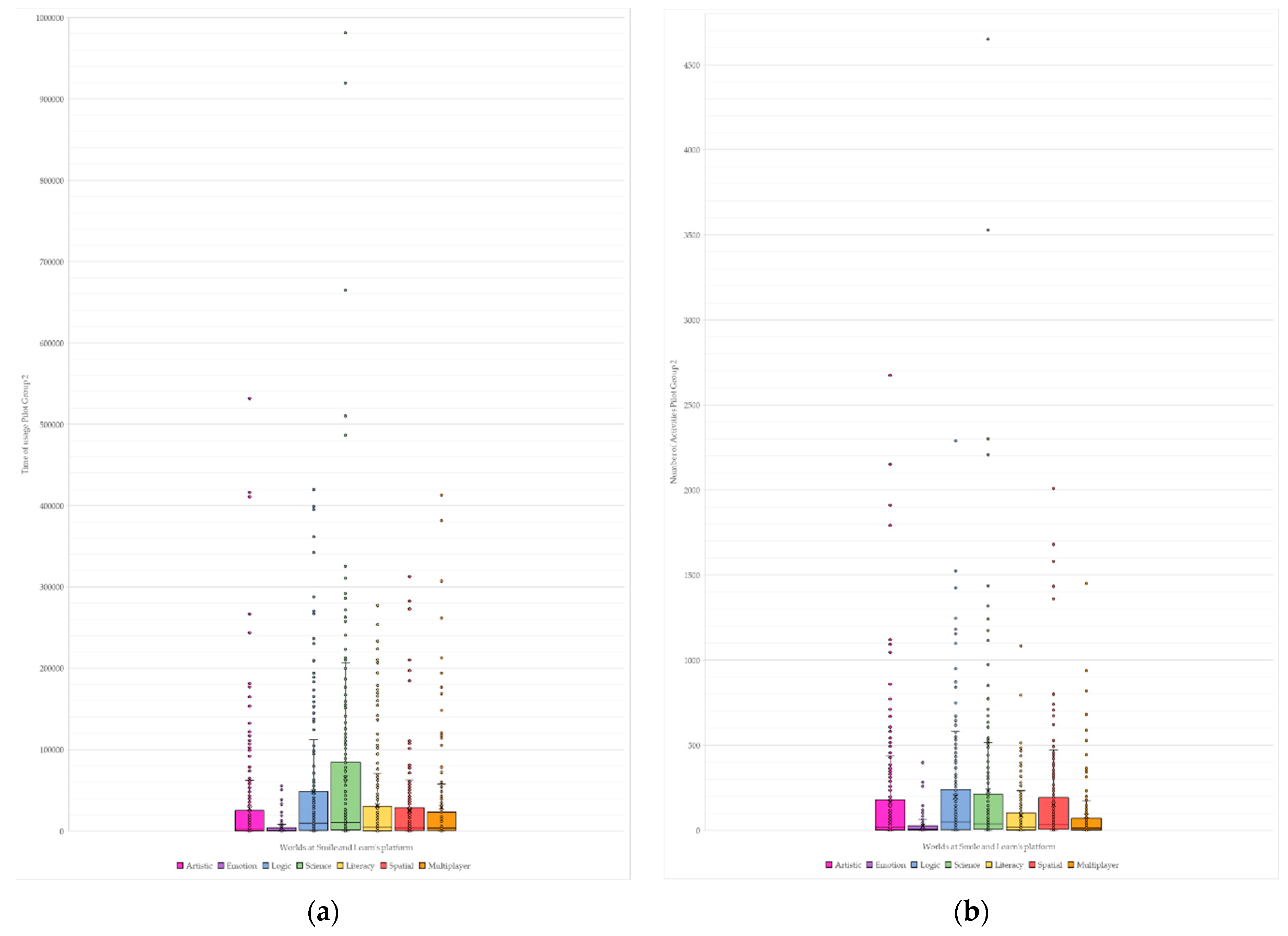
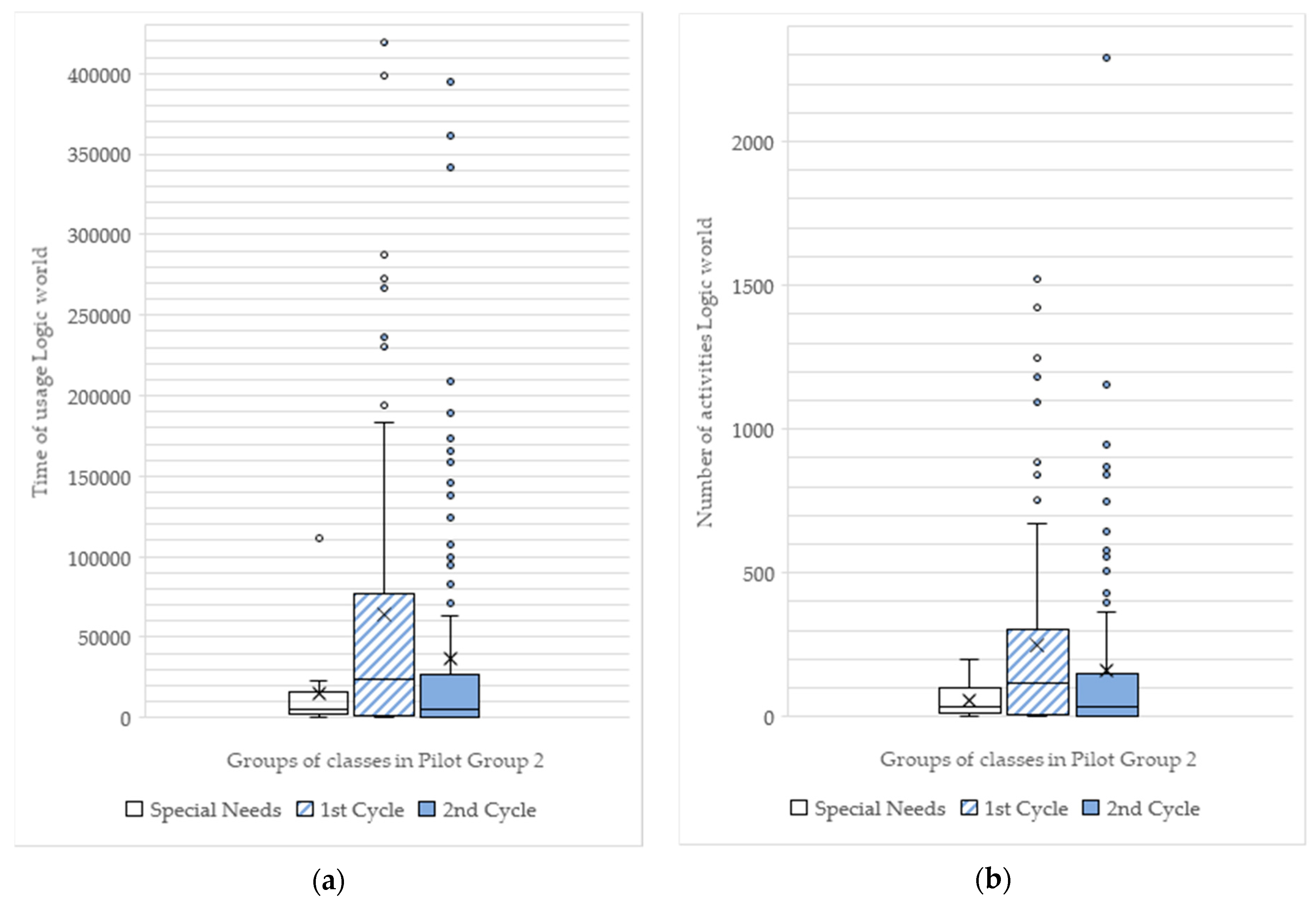
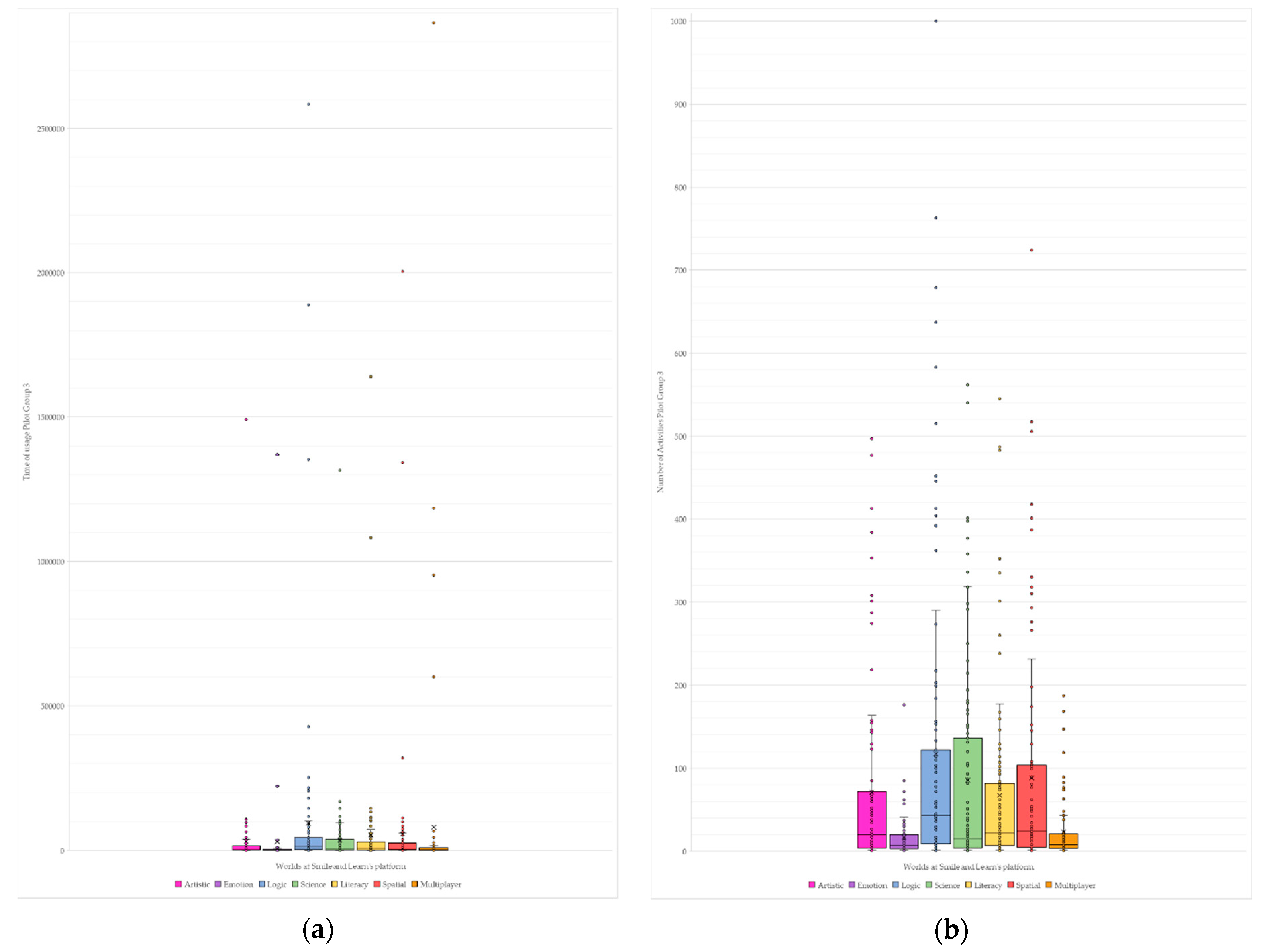
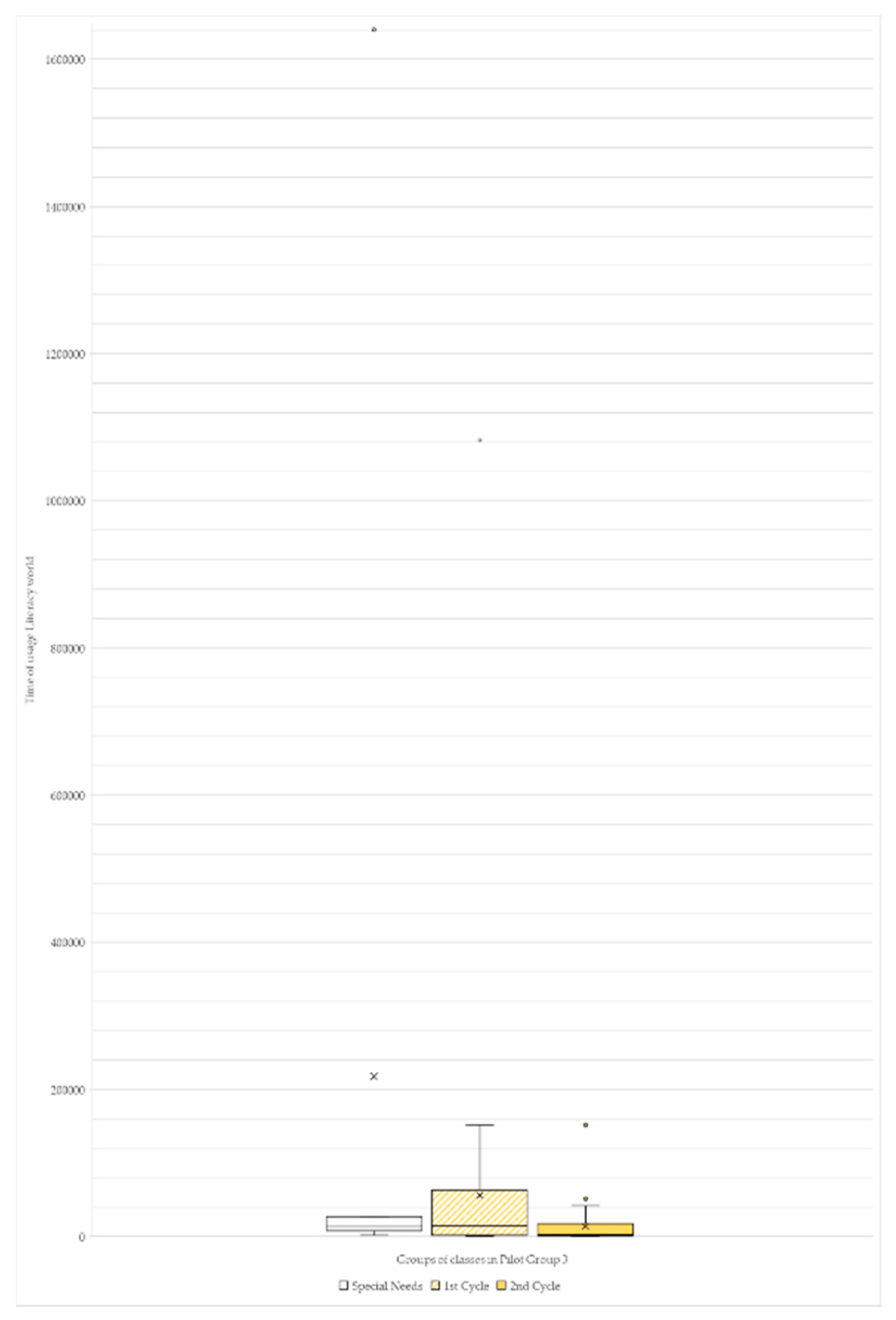
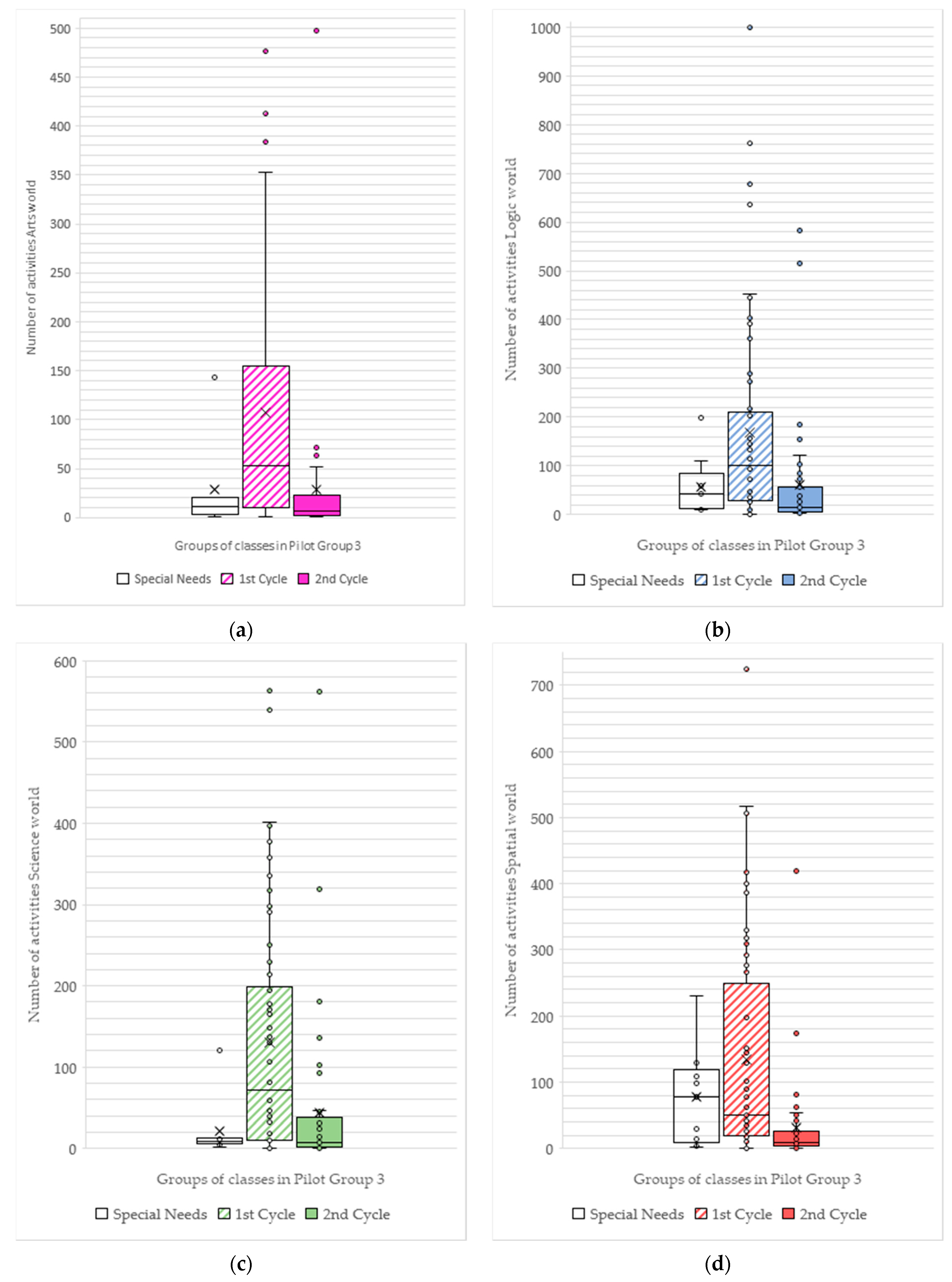
© 2020 by the authors. Licensee MDPI, Basel, Switzerland. This article is an open access article distributed under the terms and conditions of the Creative Commons Attribution (CC BY) license (http://creativecommons.org/licenses/by/4.0/).
Share and Cite
Lara Nieto-Márquez, N.; Baldominos, A.; Cardeña Martínez, A.; Pérez Nieto, M.Á. An Exploratory Analysis of the Implementation and Use of an Intelligent Platform for Learning in Primary Education. Appl. Sci. 2020, 10, 983. https://doi.org/10.3390/app10030983
Lara Nieto-Márquez N, Baldominos A, Cardeña Martínez A, Pérez Nieto MÁ. An Exploratory Analysis of the Implementation and Use of an Intelligent Platform for Learning in Primary Education. Applied Sciences. 2020; 10(3):983. https://doi.org/10.3390/app10030983
Chicago/Turabian StyleLara Nieto-Márquez, Natalia, Alejandro Baldominos, Alejandro Cardeña Martínez, and Miguel Ángel Pérez Nieto. 2020. "An Exploratory Analysis of the Implementation and Use of an Intelligent Platform for Learning in Primary Education" Applied Sciences 10, no. 3: 983. https://doi.org/10.3390/app10030983
APA StyleLara Nieto-Márquez, N., Baldominos, A., Cardeña Martínez, A., & Pérez Nieto, M. Á. (2020). An Exploratory Analysis of the Implementation and Use of an Intelligent Platform for Learning in Primary Education. Applied Sciences, 10(3), 983. https://doi.org/10.3390/app10030983





